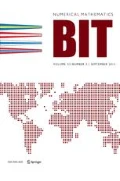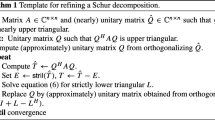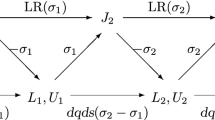Abstract
We present a numerical algorithm for computing the implicit QR factorization of a product of three matrices, and we illustrate the technique by applying it to the generalized total least squares and the restricted total least squares problems. We also demonstrate how to take advantage of the block structures of the underlying matrices in order to reduce the computational work.
Similar content being viewed by others
References
Å. Björck.Difference Methods-Solutions of Equations in R n, volume I ofHandbook of Numerical Analysis, Chapter Least Squares Methods. Elsevier Publishers, 1990.
T. Chan.Rank-revealing QR factorizations, Lin. Alg. and Its Applic. 88/89, 67–82, 1987.
G. Golub, C. Van Loan.Matrix Computations. The Johns Hopkins University Press, Second Edition, 1989.
C. Paige.Fast numerically stable computations for generalized linear least squares problems, Mathematics of Computation, 33, No. 145, 171–183, 1979.
C. Paige.Some aspects of generalized QR factorizations, inReliable Numerical Computation, Proceedings of the meeting at NPL Teddington, 8–10 July 1987, dedicated to the late James Hardy Wilkinson, FRS. (eds. M. Cox and S. Hammarling). Oxford University Press, 1990.
S. Van Huffel and J. Vandewalle.Analysis and properties of the generalized total least squares problem AX ≈ B when some or all columns in A are subject to error, SIAM J. Matrix Anal. Appl., 10, 294–315, 1989.
S. Van Huffel and H. Zha.The restricted total least squares problem: formulation, algorithm and properties, Numerical Analysis Project, Manuscript NA90-92, Stanford University. Accepted for publication in SIAM J. Matrix Anal. Appl.
H. Zha.The implicit QR decomposition and its applications, ESAT-SISTA report 1989-25, Department of Electrical Engineering, KU Leuven, 1989.
H. Zha and P. C. Hansen.Regularization and the general Gauss-Markov Model, Math. Comp., Vol. 55, No. 192, 613–624, 1990.




